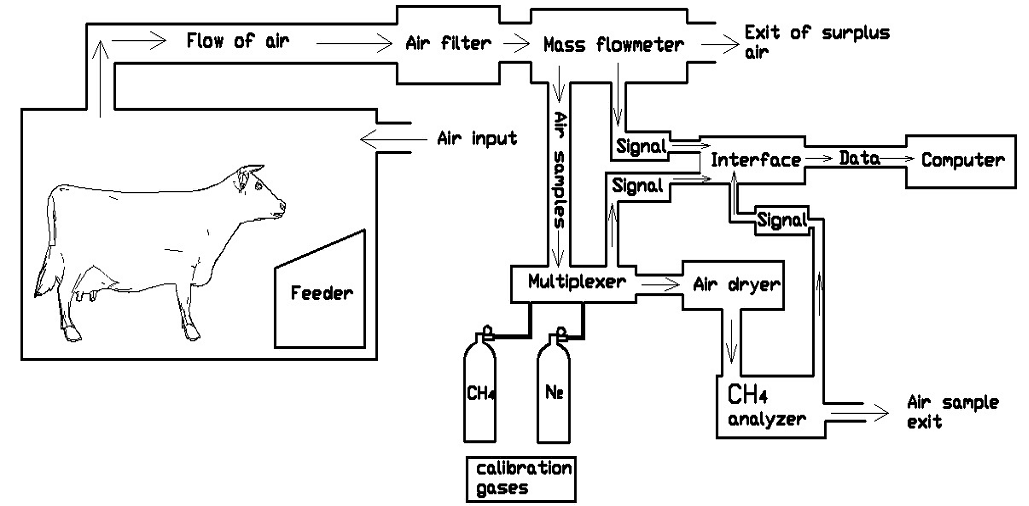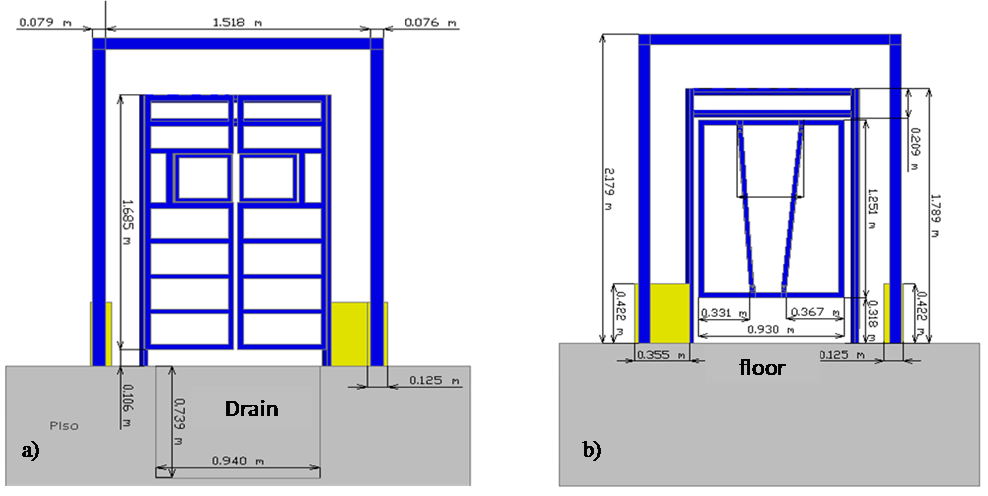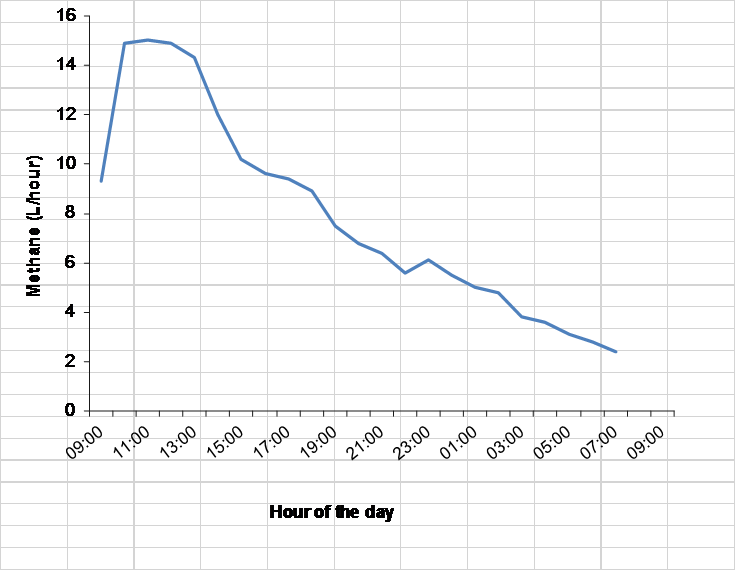Ruminant production (cattle, sheep, goats, buffalos) has been identified as one of the main sources of emissions of greenhouse gases (GHG) in the world1,2. Around 39 % of anthropogenic emissions of GHG are attributed to ruminant production2, which accounts for approximately 140 Tg of CO2 equivalents3. Due to this, there is a growing interest for studying options which may contribute to reduce methane emissions arising from ruminant production2,4,5. It is estimated that 95 % of methane emitted to the environment arises from the livestock sector6,7. However, this information has been estimated by using IPCC (International Panel on Climate Change) Tier 2 equations, which present high variability8,9. This suggests the urgent need to carry out in vivo measurements of methane production in ruminants to derive reliable inventories of emissions and to establish public policies on this subject at governmental level in Mexico. The indirect-calorimetric technique has been used since many years ago for the measurement of heat production in ruminants10,11,12 and at the present time this is the technique most employed for measuring methane production in domestic ruminants13. Recently, in various laboratories around the world, respiration chambers have been built to quantify methane production in ruminants14,15,16. Respiration chamber instrumentation is one the most precise techniques for measuring the emissions of enteric methane17,18,19. The aim of the present work was to describe the design, construction and operation of respiration chambers for in vivo measurement of methane production in cattle in Mexico.
Two respiration chambers of an appropriate size for housing cattle were built during 2013 at the Department of Animal Nutrition, Faculty of Veterinary Medicine and Animal Science, University of Yucatan, in Merida, Mexico. Chambers were designed to give cattle comfort in terms of space, relative humidity and temperature, in order to comply with welfare regulations for the treatment of experimental animals in Mexico. Respiration chambers and the procedures for operation consist of three parts: 1) Respiration chambers, 2) Sampling and analysis of methane gas, and 3) Capture and transformation of data.
Respiration chambers were designed under the principle of open-circuit indirect-calorimetry16,20. In the open-circuit indirect-calorimetry technique, external air is allowed into the chamber where it is mixed with the gases exhaled by the animal in it, and then that mixture is drawn by means of a pump through an outlet towards the gas analyzer where they are quantitatively measured (Figure 1)13. Respiration chambers were built with a metabolic crate for cattle inside them for the quantitative collection of feces and urine. In the design it was important to provide the animal with enough space to stand and lie down freely, access to water and a feeder of appropriate capacity, consistent with the best welfare and comfort possible. Chamber dimensions were: 300 cm length, 214 cm height and 144 cm wide; the volume was thus 9.97 m3. The lateral base of the chamber walls has 50 cm height concrete (Figure 2). The structure of the chambers was built with 5.08 cm steel angle on which thermic panels of 5.08 cm width were tightly fitted to form the lateral walls (315 cm x 170 cm, length and height, respectively). The thermic panels are made of galvanized sheet metal (caliber 14) filled with polyurethane insulating foam. In the front part of the chambers at both sides, windows of transparent acrylic (9 mm width; 94 cm length and 155 cm height) were fitted to allow the observation of the animals at all times, thus avoiding unnecessary stress. Thermic panels were fitted with angles of steel sheet caliber 14; these angles were fitted to the walls and metallic structure of the chambers with screws of 0.95 cm. Before joining the angles to the metallic structure of the chambers, these were painted with anticorrosive paint. Chamber doors were built of thermic panels. Front doors have dimensions 2.04 m height x 1.26 m width; while the rear door measures 274 cm height x 154 cm width. Doors were fitted to frames built of wood covered with steel sheet with two folding door hinges (Calce-Laminite®) made of stainless steel. The roof was covered with a single thermic panel, which was fitted to the steel frame (angle) with 0.95 cm screws to obtain a hermetic seal before a final sealing with paste sealant urethane (Construflex®, Multiaccesorios Monterrey, Mexico) in all the metal-metal joints. Inside each chamber there is a metabolic cage manufactured with galvanized tubes (5.0 cm) with dimensions 320 cm length x 100 cm width x 180 cm height respectively. The rear end of the metabolic cage has a door to securely enclose the animal and to protect the personal, which are cleaning or sampling feces, urine and blood (Figures 2 and 3).

Figure 1. Scheme of the respiration chambers for methane measurements in cattle at the University of Yucatan, Mexico

Figure 2. Cross lateral section of the metabolic stall to contain cattle inside the respiration chambers

Figure 3. a) Scheme of the dimensions of the rear section of the respiration chambers; b) Scheme of dimensions of the front section of the respiration chambers
Feeding troughs inside the respiration chambers were designed to minimize waste of feed outside the feeder, they have dimensions 90 cm length, 70 cm height and 50 cm width. Feeders were built of steel angles of 2.54 cm and steel sheet (caliber 14). At the front of the feeder an adjustable metal structure was fitted to contain the animal from stepping into the feeder and waste the grass inside it. Feeders were fitted with four small wheels (2.54 cm of diameter) to facilitate feeding of the animals. An automatic bowl-type waterer (20 cm diameter) was installed inside each chamber to provide fresh water at all times. Continuous flow of water is maintained by means of a hydraulic system from the water tank above the chamber. Temperature inside the chamber is tightly controlled with an air conditioning unit (Mirage EXF121D, Bristol International, Mexico) of 12,000 British Thermal Units. Chambers are provided with artificial light with 20 watts lamps (MOD: FH-E20, High Power, China). Outside air enters the chamber via a small valve in the front part is mixed and homogenized with air exhaled by the animal by means of a small fan (Grand V.E.C, China) fitted in the upper front part of the chamber. Relative humidity of air inside the chamber is maintained at 55 % by using a dehumidifier unit (Green Soleusa Air, Excell Industries, Miami, Florida USA). Barometric pressure inside the chamber is maintained negative at around -344 Pa, which is continuously checked with a portable differential pressure manometer (Heavy Duty Series 407910, Extech Instruments Corporation, USA). All joints between walls and the roof of the chamber were sealed with three layers of urethane sealant (Construflex®, Multiaccesorios Monterrey, Mexico). Chamber doors seal hermetically by the action of refrigerator rubber sealants fitted along the length of the door and frame of the doors; additionally poliflex tape (No. 565, USA) was fitted as an insulating material. Electric power (lamps, air conditioning), water line and differential pressure recording line, enter the chamber through a hole (25.0 cm) in the roof which was sealed with paste of urethane (Construflex®, Multiaccesorios Monterrey, Mexico). Similarly, water draining lines for the dehumidifier (polyvinylchloride 1.90 cm of diameter) and the air conditioning unit, leave the chamber by means of a hole drilled at the bottom (polyvinyl-chloride 1.90 cm of diameter) of the chamber which was sealed with concrete.
Air inside the chamber is drawn through an industrial hose (1.90 cm diameter) to the analytical room for gas analysis and calculations. The hose is insulated from environmental stressors with Aislaflex (Proflex ®; Armacell USA) and covered with polyvinyl-chloride tube of 4 inches internal diameter for additional protection (from birds and lizards which may damage it). There are two filters before air is directed into the methane analyzer; the first is fixed at the outlet inside the chamber, this is homemade with two layers of screen of 1 mm mesh size. At the other end of the hose, there is an air filter (Sable Systems International, Las Vegas, USA) to capture dust, hair and other incoming particles. All air lines are sealed with urethane sealant (Construflex®, Multiaccesorios Monterrey, Mexico). Air exiting the chambers drawn by a mass flowmeter (Flowkit 500; Sable Systems, Las Vegas, USA) at a rate of between 300 to 500 L per minute. The air sample is passed through a multiplexer (Sable Systems International, Las Vegas, USA) and then through a chemical desiccant (silica gel column, Reagents Chemical Meyer, Mexico) before entering the methane infrared analyzer (MA-10 Sable Systems International, Las Vegas, USA), and the excess air is blown outside the laboratory through a pipe. Data registered in the methane analyzer is send as voltage signals by means of an interface to the computer.
Voltage data from the analyzer is processed in the computer with ExpeData® software (Sable Systems International, Las Vegas, USA). ExpeData records air flow rates through the system and methane concentration in air samples is measured by the methane analyzer continuously during the day. Data on methane concentration in air samples is registered alternatively between chambers, one during 25 min at 10 min pause (baseline), and then followed by 25 min in chamber 2 throughout the day. Measurement time in each chamber is 25 min, with sampling time every 10 sec within a chamber. Methane production is calculated based on mean rate of methane production per minute and flow rate per unit time. Methane is measured simultaneously in the two chambers with a pause. It is known, at least theoretically, that background methane must be measured, however, under our conditions methane in the background was found to be negligible so corrections were considered unnecessary. All data is corrected to standard temperature and pressure dry (STPD). Similarly, a correction factor for air flow per unit time is calculated to correct all airflow data. Cattle are kept in the chambers for 3 d, at the end of a run animals are taken off the chambers and other animals in the experiment enter the chambers.
The methane analyzer was calibrated every day before a run by releasing both pure N2 (99.999%; Praxair, Mexico) to zero (baseline) the apparatus and then CH4 (1,000, 2,500, 5,000 and 7,500 ppm) diluted in nitrogen is infused to assess the linearity of the apparatus response. In addition, ultrapure CH4 (99.99 %; Praxair, USA) was released from a small cylinder into the chambers to assess the recovery rate, this fluctuated between 98.5 and 100.2 %. Chambers were tested for negative pressure with a result of -551 Pa, so it was assumed that no air leakages occurred from the chambers to the outside.
The functioning of the chambers was evaluated with two Bos indicus (Zebu) Nelore bulls weighing 350 kg live-weight. The measurements were carried out in runs of 23 h. Each animal was kept during 3 d, first in one chamber and then changed for 3 d to the second chamber. The animals were kept at a temperature of 23 °C and relative humidity of 55 % inside of chambers. Cattle were fed Taiwan grass (Pennisetum purpureum) chopped with a particle size of approximately 3 cm and a concentrate (18 % crude protein). Daily dry matter (DM) intake was recorded in each animal during the experimental period.
Enteric methane production of the Zebu bulls was on average 173.2 L per day (Table 1), while the emission factor was 17.5 L methane per kg DM consumed. Under our conditions, it was found that methane production by cattle was highly correlated with daily variations on dry matter intake (Y= 36.049X-196.94; R2=0.8673), as shown in Figure 4. This has been also found in our preliminary measurements at this laboratory, where methane production of cattle varies throughout the day. Figure 5 shows this behavior. The recovery factor (98.5 to 100.2 %) for methane obtained during calibration of the respiration chambers (by infusing pure methane) compares well with data obtained for calibration of this type of instrumentation elsewhere in the world21. Tests of linearity of the methane analyzer carried out with cylinders containing methane (1,000; 2,500; 5,000 and 7,500 ppm) diluted in N2, gave consistently a coefficient of determination (r2) of 0.9999.
Table 1. Average of daily methane production of Nellore cattle fed forage:concentrate (92:8) ration and confined in respiration chambers

FC= Forage:concentrate; LW= Live weight; MBW= Metabolic body weight (live weight [kg] raised to the power 0.75); DMI= Dry matter intake.

Figure 4. Effect of dry matter intake on methane production in Nellore cattle housed in respiration chambers

Figure 5. Hourly production of methane in a Nellore bull consuming 10 kg of dry food per day (fed at 0850 h; hour 1 of the day= 0900 h)
The data on methane production by Zebu cattle so far obtained in this trial compares well with results from Kennedy and Charmley22 with Zebu cattle in Australia, where they found 151.9 L of methane per day in cattle fed tropical pastures. Kurihara et al23 reported a production of 363.9 L of methane per day in cattle of similar weight; while others24 recorded a production of 68.5 L methane per day in bulls of 322 kg live-weight fed a concentrate ration.
It was found that methane production in cattle was highly correlated with dry matter intake and the quality of the ration consumed (Figure 5). Similar results were reported by Blaxter and Clapperton25 who mentioned that intake and digestibility of the ration directly affect methane production. These data are comparable with that obtained with steers grazing alfalfa/grass mixtures with a methane production of 19.84 L methane per kg DM consumed26. Other report27 mentioned that methane production of cattle varies throughout the day occurring production peaks which are due to the different rates of fermentation of carbohydrates in the rumen. This has been also found in preliminary measurements at this laboratory, where methane production varies throughout the day. Figure 5 shows this behavior.
In conclusion, two large respiration chambers for cattle were built at a cost of US $ 89,000.00 in Mexico. They are fully operational and measurements of enteric methane are being carried out systematically with cattle. No behavioral stress can be noticed when cattle are confined in the respiration chambers. Chambers have been tested for methane gas recovery obtaining good recovery values.











 nueva página del texto (beta)
nueva página del texto (beta)


